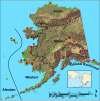Prevalence of Influenza A viruses in wild migratory birds in Alaska: patterns of variation in detection at a crossroads of intercontinental flyways
- PMID: 18533040
- PMCID: PMC2435106
- DOI: 10.1186/1743-422X-5-71
Prevalence of Influenza A viruses in wild migratory birds in Alaska: patterns of variation in detection at a crossroads of intercontinental flyways
Abstract
Background: The global spread of the highly pathogenic avian influenza H5N1 virus has stimulated interest in a better understanding of the mechanisms of H5N1 dispersal, including the potential role of migratory birds as carriers. Although wild birds have been found dead during H5N1 outbreaks, evidence suggests that others have survived natural infections, and recent studies have shown several species of ducks capable of surviving experimental inoculations of H5N1 and shedding virus. To investigate the possibility of migratory birds as a means of H5N1 dispersal into North America, we monitored for the virus in a surveillance program based on the risk that wild birds may carry the virus from Asia.
Results: Of 16,797 birds sampled in Alaska between May 2006 and March 2007, low pathogenic avian influenza viruses were detected in 1.7% by rRT-PCR but no highly pathogenic viruses were found. Our data suggest that prevalence varied among sampling locations, species (highest in waterfowl, lowest in passerines), ages (juveniles higher than adults), sexes (males higher than females), date (highest in autumn), and analytical technique (rRT-PCR prevalence = 1.7%; virus isolation prevalence = 1.5%).
Conclusion: The prevalence of low pathogenic avian influenza viruses isolated from wild birds depends on biological, temporal, and geographical factors, as well as testing methods. Future studies should control for, or sample across, these sources of variation to allow direct comparison of prevalence rates.
Figures


Similar articles
-
Characterizing wild bird contact and seropositivity to highly pathogenic avian influenza A (H5N1) virus in Alaskan residents.Influenza Other Respir Viruses. 2014 Sep;8(5):516-23. doi: 10.1111/irv.12253. Epub 2014 May 14. Influenza Other Respir Viruses. 2014. PMID: 24828535 Free PMC article.
-
Evidence for common ancestry among viruses isolated from wild birds in Beringia and highly pathogenic intercontinental reassortant H5N1 and H5N2 influenza A viruses.Infect Genet Evol. 2016 Jun;40:176-185. doi: 10.1016/j.meegid.2016.02.035. Epub 2016 Mar 2. Infect Genet Evol. 2016. PMID: 26944444
-
Movements of birds and avian influenza from Asia into Alaska.Emerg Infect Dis. 2007 Apr;13(4):547-52. doi: 10.3201/eid1304.061072. Emerg Infect Dis. 2007. PMID: 17553268 Free PMC article.
-
Origin and evolution of highly pathogenic H5N1 avian influenza in Asia.Vet Rec. 2005 Aug 6;157(6):159-64. doi: 10.1136/vr.157.6.159. Vet Rec. 2005. PMID: 16085721 Review.
-
Avian influenza virus: of virus and bird ecology.Vaccine. 2009 Oct 23;27(45):6340-4. doi: 10.1016/j.vaccine.2009.02.082. Epub 2009 Mar 9. Vaccine. 2009. PMID: 19840670 Review.
Cited by
-
Model-based evaluation of highly and low pathogenic avian influenza dynamics in wild birds.PLoS One. 2010 Jun 23;5(6):e10997. doi: 10.1371/journal.pone.0010997. PLoS One. 2010. PMID: 20585637 Free PMC article.
-
Diffusion of influenza viruses among migratory birds with a focus on the Southwest United States.Infect Genet Evol. 2014 Aug;26:185-93. doi: 10.1016/j.meegid.2014.05.029. Epub 2014 Jun 6. Infect Genet Evol. 2014. PMID: 24910106 Free PMC article.
-
Epidemiology and Ecology of Influenza A Viruses among Wildlife in the Arctic.Viruses. 2022 Jul 13;14(7):1531. doi: 10.3390/v14071531. Viruses. 2022. PMID: 35891510 Free PMC article.
-
Demographic and Spatiotemporal Patterns of Avian Influenza Infection at the Continental Scale, and in Relation to Annual Life Cycle of a Migratory Host.PLoS One. 2015 Jun 25;10(6):e0130662. doi: 10.1371/journal.pone.0130662. eCollection 2015. PLoS One. 2015. PMID: 26110538 Free PMC article.
-
Are passerine birds reservoirs for influenza A viruses?J Wildl Dis. 2014 Oct;50(4):792-809. doi: 10.7589/2014-02-043. Epub 2014 Aug 14. J Wildl Dis. 2014. PMID: 25121402 Free PMC article. Review.
References
-
- Gauthier-Clerc M, Lebarbenchon C, Thomas F. Recent expansion of highly pathogenic avian influenza H5N1: a critical review. Ibis. 2007;149:202–214. doi: 10.1111/j.1474-919X.2007.00699.x. - DOI
-
- Chen H, Smith GJ, Li KS, Wang J, Fan XH, Rayner JM, Vijaykrishna D, Zhang JX, Zhang LJ, Guo CT, Cheung CL, Xu KM, Duan L, Huang K, Qin K, Leung YH, Wu WL, Lu HR, Chen Y, Xia NS, Naipospos TS, Yuen KY, Hassan SS, Bahri S, Nguyen TD, Webster RG, Peiris JS, Guan Y. Establishment of multiple sublineages of H5N1 influenza virus in Asia: implications for pandemic control. Proc Natl Acad Sci USA. 2006;103:2845–2850. doi: 10.1073/pnas.0511120103. - DOI - PMC - PubMed
Publication types
MeSH terms
LinkOut - more resources
Full Text Sources
Medical

